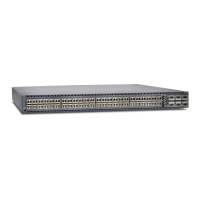user@host# set mode reflect
13. Configure the address type family, inet, for the benchmarking test.
[edit services rpm rfc2544-benchmarking tests test-name test1]
user@host# set family inet
14. Configure the destination IPv4 address for the test packets as 200.0.0.1.
[edit services rpm rfc2544-benchmarking tests test-name test1]
user@host# set dest-address 200.0.0.1
15. Specify the UDP port of the destination to be used in the UDP header for the
generated frames as 4001.
[edit services rpm rfc2544-benchmarking tests test-name test1]
user@host# set udp-port 4001
16. Start the benchmarking test on the reflector.
user@host> test services rpm rfc2544-benchmarking test test1 start
After the test is successfully completed at the initiator, you can stop the test at the
reflector by entering the test services rpm rfc2544-benchmarking test test1 start
command.
Results
In configuration mode, confirm your configuration on Router A and Router B by entering
the show command. If the output does not display the intended configuration, repeat
the configuration instructions in this example to correct it.
Configuring Benchmarking Test Parameters on Router A:
[edit interfaces]
ge-0/0/0 {
unit 0 {
family inet {
address 200.0.0.1/24;
}
}
}
[edit services rpm]
rfc2544-benchmarking {
profiles {
test-profile throughput {
test-type throughput
packet-size 64;
test-duration 20m;
bandwidth-kbps 500;
}
}
tests {
1365Copyright © 2017, Juniper Networks, Inc.
Chapter 37: Configuring RFC 2544-Based Benchmarking Tests

